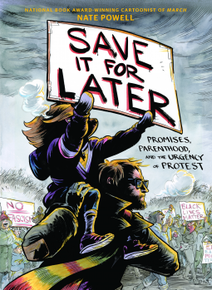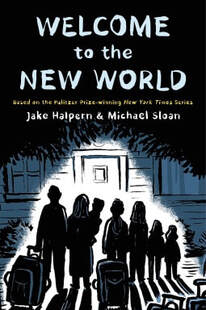
In this memoir manga, Pesayuma-san goes through their beginnings of being a manga artist, reflecting on their childhood, and grappling with their gender and sexuality. In their second job in the manga industry, Pesayuma was sexually assaulted and objectified by a male coworker, and the trauma from this incident left them emotionally scarred and vulnerable for seven years. After finding a new editor in a post Me-Too world, Pesayuma discovers that they could take legal action against their aggressor, but also that their story could be publishable. They reflect on some fundamental people from their childhood and moments that were formative in their life as they journey towards self-discovery.
0 Comments

Illustrated by Nate Powell
The final book in this trilogy picks up with events early in 1963 when a church in Birmingham was bombed, and four young girls were killed. John Lewis and SNCC (Student Nonviolent Coordinating Committee) and other Civil Rights groups came together after that bombing to try to get more representation on a state and national level since their local politicians were going to continue to turn a blind eye to violence. They organized into the Freedom Democratic Party and tried to take part in the Democratic National Convention, but drew the ire of LBJ in his re-election campaign. Larger demonstrations were necessary as violence mounted and became more blatant. Lewis and his fellows conceived of a march from Selma, Alabama, to the capital in Montgomery, an event that is now referred to as "Bloody Sunday" because of how badly law enforcement officers beat demonstrators. After that terrible day, another march was planned with Lewis and Martin Luther King, Jr., and this time, they were successful in reaching Montgomery. The finale ties together Lewis and Aydin discussing commemorating all the important work of Lewis' life into a comicbook. 
Illustrated by Nate Powell
In this second volume of the life of former Senator John Lewis, we see Lewis as a college student who is getting more and more involved in the racial protests in the South. Lewis was one of the first and longest members of the Freedom Riders group who bought tickets on buses going between several states and challenged bus company's rules that buses needed to be segregated. This was in direct violation of the Supreme Court ruling in Morgan v. Virginia where the court found segregated buses to be unconstitutional. Lewis narrowly missed being on one of the buses that was attacked and torched by KKK members. On several occasions, Lewis and other riders were jailed and refused to post bail, saying that paying it would then fund the racist policies they were fighting against. Lewis gets more involved with Dr. King, and is selected as one of the six representatives to meet with President Kennedy on the racial tensions in the south. Lewis is elected the president of SYNC, and later is the last speaker at the March on Washington for Jobs and Freedom where King delivered his famous, "I Have a Dream Speech." Included in end notes is the full text of Lewis' speech, called "This is It". 
Katie struggles with food as a child, not wanting to eat what her parents gave her and finding interesting ways to hide what she didn’t want to eat. She gives up junk food for lent one year and finds that after her diet change, junk food doesn’t sit well anymore. She starts regulating her food intake and counting calories. She also does lots of long walks to make up for even the slightest slip up. She continues on until she passes out from near-starvation. Her parents rush her to the hospital where she is diagnosed with Anorexia Nervosa. Katie continues to struggle throughout high school and into college, not only with food, but her ability to control her body, her food, and her doubts and anxieties. Just when she thinks she’s found someone to help her heal, it turns out to be even more harmful when Katie realizes she is being sexually assaulted by the one person she had trusted with her recovery.

Illustrated by Nate Powell
On the morning of Barack Obama’s inauguration to his first term as president, Congressman John Lewis readies himself in his office in Washington D.C. A lady with two kids stops by the office, obviously not expecting the Congressman to be there, but they are delighted to find him and ask questions about his life and his involvement in the Civil Rights Movement. This launches Lewis down memory lane as he recounts his childhood from growing up on a farm, raising chickens, to going to school and getting involved in sit ins at local department store lunch counters. The work isn't done with those demonstrations, as later volumes promise to hold other activism and demonstrations Lewis took part in and led. 
This collection of graphic essays presents Nate Powell as he tackles with the election of 2016, difficult conversations he has with his young daughter on the power of protest and symbols (especially those used by white supremacists), and the effect of the Global Pandemic on his family and his mental state. In early chapters, Powell recounts telling his children about then-candidate Trump (although not specifically named until the end of the book). As white supremacy becomes a more visible component of American society, Powell reflects on writing March with John Lewis and Andrew Aydin, and trying to reconcile those protest movements with the marches by Neo Nazis through his city and state. In the last chapter, Powell has a call-to-arms where he challenges others not to passively agree with others who are protesting, but to do some of it for yourself as well.

Illustrated by Tim Foley
Dan Rather's original prose book, What Unites Us, is a collection of essays, musings and observations with lots of autobiographical details, about American history and political climate. This graphic novel adapts many of the essays from the prose version. The historical events are not told in any sort of chronological order. Instead, Rather uses his perspective on key historical moments to illustrate bigger ideologies; things like "courage", or "patriotism." Rather attempts to explain what is special about America, what brings us together as a nation, but also what has worked to separate us, especially partisan bickering and political turmoil. 
Fights: One Boy's Triumph Over Violence is an autobiographical memoir of Joel’s childhood. As a small boy, he is forced to learn how to fight in order to protect himself from kids at school and in his neighborhood. He makes the assertion that children are sponges so can only absorb so much violence and negativity before it explodes out of them, often violently as well. As he grows, Joel learns to control his outbursts and tries to get away from the constant threat of violence, but he is frequently the target of other people’s anger. As he becomes a teenager, he becomes a target for other males well don’t like how popular he is with the ladies, and he also gets on the wrong side of drug dealers.

Illustrated by Michael Sloan
In the Fall of 2016, the Aldabaan family receives word that they have been approved to travel from Jordan to the United States. Brothers Ibrahim and Issa are able to emigrate with their families, but they are leaving behind their mother and another brother and family. This is after they have all fled war-torn Syria. The eldest son, Naji, can't wait for the family to start their new lives in the United States, but the political climate has Ibrahim and his wife, Adeebah, unsure of what they're going in to. Once in Connecticut, they receive help from IRIS, a refugee resettlement agency, and told that they need to become self-sufficient within four months. The whole family adjusts to oddities of America, such as basements and Life Alert. Naji and his sister, Amal, start school and are treated as outcasts. The family constantly wonders if they've really left behind the worse life. 
Illustrated by Sonia Paoloni and Thibault Balahy
Delve into the formation of the first all American Indian Rock Band: Redbone, as told from Pat Vegas’ perspective. Before they were a full band, Lolly and Pat Vegas played clubs in LA and jammed with some of the greats - Jimmy Hendrix before he was Jimi, Sonny and Cher, and more. They start to collect other talented musicians who were also passing as Hispanic Americans, and formed a band that then went on to proudly use elements of Native American instruments and musicality in their songs and display their Native American heritage. While they weren't always a commercial success, and their ancestry brought them discrimination and missed gigs, the members of Redbone felt it was necessary to continue their musical careers as noble Native Americans who would not bend to the pressure of their record label or the music industry. |
About MeI've been reading manga and comicbooks for years. Now, I write reviews and other helpful things for School Librarians, teachers, parents, and students. Search this siteRatings, Audience, and Subject Tags
All
Archives
July 2024
|




